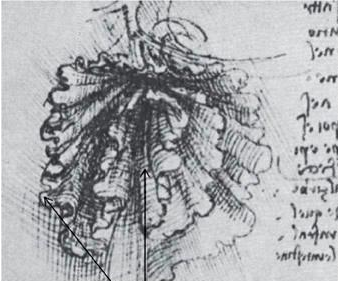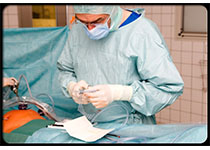Scientific Reports:间质 ——被传统解剖学遗漏的“新器官”?
2018-03-31 佚名 生物探索
3月27日,《Scientific Reports》期刊发表一篇很有意思的文章,揭示了一种被传统解剖学长期遗漏的结构——间质(interstitium).因为广泛存在于全身、且参与多种生物学过程,所以被科学家们第一次定义为“新器官”。
这篇题为“Structure and Distribution of an Unrecognized Interstitium in Human Tissues”的文章由纽约大学的科学家们完成,他们发现,粘膜下层中存在一种充满液体的网格空间结构,即interstitium,由胶原纤维束包裹间质液而成。
这一结构的发现颠覆了传统解剖学所认为的“致密的结缔组织”观点。通常病理学研究会将采集的活体组织经过化学处理,使其得以“固定”,在显微镜下进行观察,从而解析机体构成。
研究团队认为,interstitium是一种广泛存在于身体内的器官,与淋巴系统有关联,并有可能参与癌症转移。
新器官?
纽约大学的病理学教授Neil Theise和团队利用了一种新技术——基于探针的激光共聚焦显微内镜(pCLE),可以在内窥镜检查时,以高分辨率实时观测活体组织成像。研究招募了12名癌症患者,将接受手术切除胆管和胰脏组织。在切除之前,研究人员利用pCLE技术实时观察了胆管周围组织。
意外的是,在固定的胆管切片中他们只观察到致密的结缔组织,但是活体组织成像却显示出包含液体的网状空间结构,即Interstitium。另外,移出液体会导致Interstitium的蛋白网络“坍塌”。这或许可以解释为什么固定的样本没有间质存在了。
更重要的是,除了胆管,Interstitium广泛分布于全身,包括皮肤真皮层、胃肠道、肺部、泌尿系统、血管等几乎所有器官和组织的粘膜下层。
Illustration of the interstitium, fluid-filled spaces supported by a network of collagen bundles, lined on one side with cells
JILL GREGORY, REPRINTED WITH PERMISSION FROM MOUNT SINAI HEALTH SYSTEM, LICENSED UNDER CC-BY-ND.
功能
Interstitium是一个充满液体的网格状空间结构。其中,网格由胶原蛋白束构成,包裹的液体被称为间质液。另外,携带有两种标志物的扁平细胞不规则排列在蛋白束上。
Interstitium可以起到类似于减震器的作用,保护组织、肌肉、血管在日常工作中免于拉伤。研究发现,间质是淋巴液的来源。此外,间质会伴随年龄的增长而变化,可能与皮肤皱纹、四肢僵硬以及纤维化、炎症疾病等有关。研究人员推测,这些细胞很有可能是间质干细胞。而且间质构成蛋白会伴随组织器官的运动而产生电流,可能发挥类似于针灸的作用。
更重要的是,因为液体具有流动性,所以,这一结构或许可以解释“为什么侵入其中的癌细胞更容易扩散”这一问题。
Image of fresh-frozen human bile duct (left) shows collagen bundles in blue; the asterisks mark fluid-filled spaces of the interstitium. Images of a fixed bile duct from the same patient (upper and lower right) show the collapse of spaces (arrowheads in bottom panel) and collagen bundles sticking together.
BENIAS ET AL., SCIENTIFIC REPORTS, 2018.
质疑
不过,这一大胆结论并未得到一致认可。有学者认为,interstitium可能在机体内发挥着重要作用,但是并不应该划为器官。而且,这一研究仅限于少量的患者。
“组织学家、病理学家很早就知道组织之间存在包含液体的空隙。” 克萨斯大学MD安德森癌症中心的病理学家Anirban Maitra认为,将interstitium归纳为迄今为止尚未被发现的最大器官比较牵强。如果按照这一定义,腹腔、胸膜腔也应该可以被称为器官。
科学从来不是静止不前的,关于interstitium的存在、功能以及争议或许可以在接下来更多的研究中找到答案。
原始出处:
Petros C. Benias, Rebecca G. Wells, et al. Structure and Distribution of an Unrecognized Interstitium in Human Tissues. Scientific Reports 8, 4947.
版权声明:
本网站所有内容来源注明为“梅斯医学”或“MedSci原创”的文字、图片和音视频资料,版权均属于梅斯医学所有。非经授权,任何媒体、网站或个人不得转载,授权转载时须注明来源为“梅斯医学”。其它来源的文章系转载文章,或“梅斯号”自媒体发布的文章,仅系出于传递更多信息之目的,本站仅负责审核内容合规,其内容不代表本站立场,本站不负责内容的准确性和版权。如果存在侵权、或不希望被转载的媒体或个人可与我们联系,我们将立即进行删除处理。
在此留言
本网站所有内容来源注明为“梅斯医学”或“MedSci原创”的文字、图片和音视频资料,版权均属于梅斯医学所有。非经授权,任何媒体、网站或个人不得转载,授权转载时须注明来源为“梅斯医学”。其它来源的文章系转载文章,或“梅斯号”自媒体发布的文章,仅系出于传递更多信息之目的,本站仅负责审核内容合规,其内容不代表本站立场,本站不负责内容的准确性和版权。如果存在侵权、或不希望被转载的媒体或个人可与我们联系,我们将立即进行删除处理。
在此留言










#SCIE#
27
#解剖学#
29
学习一下新发现解剖的器官
32